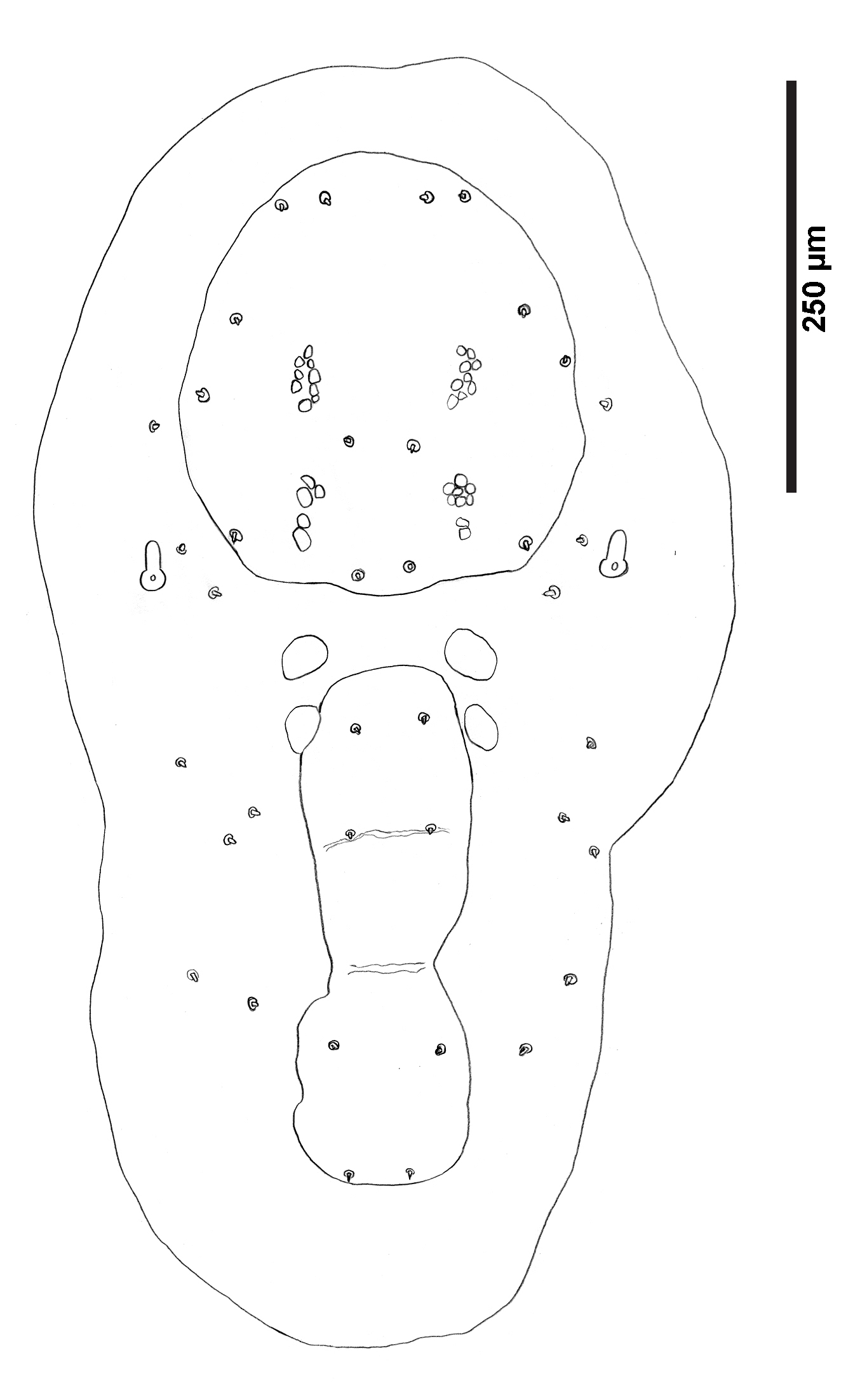
Ptilonyssus tyrannus (Brooks and Strandtmann, 1960)

Fig 98 (a). Ptilonyssus tyrannus female dorsal habitus.

Fig 98 (b). Ptilonyssus tyrannus female dorsum.

Fig 98 (c). Ptilonyssus tyrannus female venter.
Ptilonyssus (=Tyranninyssus) tyrannus (Brooks and Strandtmann, 1960)
North American host records:
Tyrannidae:
Contopus borealis,
Olive-sided
Flycatcher (Brooks and Strandtmann 1969; Hyland and Moorhouse
1970; Pence 1975)
Contopus sordidulus,
Western
Wood-Peewee (Brooks and Strandtmann 1969; Hyland and Moorhouse 1970; Pence
1975; Knee et al. 2008)
Contopus virens,
Eastern
Wood-Peewee (Pence 1972, 1975)
Empidonax alnorum,
Alder Flycatcher
(Hyland and Moorhouse 1970; Pence 1975)
Empidonax flaviventris,
Yellow-bellied
Flycatcher (Hyland and Moorhouse 1970; Pence 1975)
Empidonax minimus,
Least Flycatcher
(Brooks and Strandtmann 1969; Hyland and Moorhouse 1970; Pence 1975; Spicer 1987)
Empidonax traillii,
Willow Flycatcher
(Hyland and Moorhouse 1970; Pence 1975)
Empidonax virescens,
Acadian
Flycatcher (Pence 1972, 1975)
Sayornis phoebe,
Eastern Phoebe
(Pence 1972, 1975; Knee et al. 2008)
Sayornis saya,
Say’s Phoebe
(Brooks and Strandtmann 1969; Hyland and Moorhouse 1970;
Pence 1975)
Tyrannus melancholicus,
Tropical Kingbird
(Hyland and Moorhouse 1970)
Diagnostic characteristics:
- two dorsal
shields, podosomal and fused opisthosomal and pygidial shields
- posterior margin of podosomal shield with a medial lobe and lacking lateral
lobes
-
opisthosomal shield
is twice as long as wide
- lateral excavation of the posterior portion of the opisthosomal shield
- posterior margin of opisthosomal shield is rounded
- anterior margin of opisthosomal shield is straight
- st1 st2 and st3 off the sternal shield
- subapical ventral setal pair on tarsus IV are relatively long strong spikes with a
rounded terminus
- six pairs of ventral opisthosomal setae
- three pairs of mesolateral setae
- mesolateral setae all approximately equal in length, there are not two pairs
of setae that are twice as long as another setal pair
- subposterior
pair of dorsal podosomal setae are as long or almost
as long as the longest mesolateral setae
- dorsum of genu III with oblique row of four stout spine setae close
together
- paranal setae anterior to anal opening, paranal and postanal setae are unequal in
length
References:
Brooks, D.L., and Strandtmann, R.W. 1960. The nasal mites (Acarina) of some
West Texas
flycatchers (Tyrannidae). Journal of
Parasitology, 46: 418-432.
Hyland, K.E., and Moorhouse, A. 1970. Nasal mites from Mexican birds. I.
Rhinonyssidae
(Mesostigmata) from the host family
Tyrannidae. Acarologia, 12: 43-58.
Knee, W., Proctor,
H., and Galloway, T. 2008. Survey of nasal mites (Rhinonyssidae,
Ereynetidae,
and Turbinoptidae) associated with birds in Alberta and
Manitoba, Canada. Canadian Entomologist,
140: 364-379.
Pence, D.B. 1972. The nasal mites of birds from Louisiana III. The genus
Ptilonyssus
(Dermanyssidae: Rhinonyssinae) with
description of a new species. Journal of
Parasitology, 58: 790-795.
Pence, D.B. 1975. Keys, species and host list, and bibliography for nasal
mites of
North American birds (Acarina:
Rhinonyssinae, Turbinoptinae,
Speleognathinae, and Cytoditidae).
Special Publications of the Museum Texas
Tech University, 8: 1-148.
Spicer, G.S. 1987. Prevalence and host-parasite list of some nasal mites from
birds (Acarina:
Rhinonyssidae, Speleognathidae).
Journal of Parasitology, 73: 259-264.